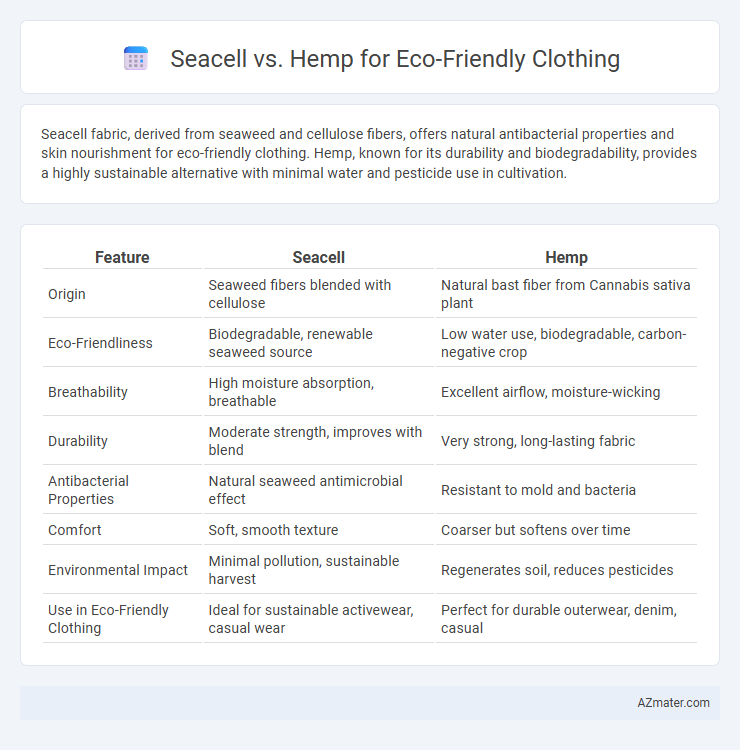Seacell fabric, derived from seaweed and cellulose fibers, offers natural antibacterial properties and skin nourishment for eco-friendly clothing. Hemp, known for its durability and biodegradability, provides a highly sustainable alternative with minimal water and pesticide use in cultivation.
Table of Comparison
| Feature | Seacell | Hemp |
|---|---|---|
| Origin | Seaweed fibers blended with cellulose | Natural bast fiber from Cannabis sativa plant |
| Eco-Friendliness | Biodegradable, renewable seaweed source | Low water use, biodegradable, carbon-negative crop |
| Breathability | High moisture absorption, breathable | Excellent airflow, moisture-wicking |
| Durability | Moderate strength, improves with blend | Very strong, long-lasting fabric |
| Antibacterial Properties | Natural seaweed antimicrobial effect | Resistant to mold and bacteria |
| Comfort | Soft, smooth texture | Coarser but softens over time |
| Environmental Impact | Minimal pollution, sustainable harvest | Regenerates soil, reduces pesticides |
| Use in Eco-Friendly Clothing | Ideal for sustainable activewear, casual wear | Perfect for durable outerwear, denim, casual |
Introduction to Eco-Friendly Fabrics
Seacell and hemp represent two innovative options in eco-friendly fabrics, combining sustainability with performance. Seacell, derived from seaweed and wood pulp, offers natural skin benefits and biodegradability, while hemp is celebrated for its durability, low water usage, and carbon sequestration properties. Both fabrics contribute to reducing environmental impact, making them ideal choices for sustainable clothing brands.
What is Seacell?
Seacell is a sustainable fabric made by blending cellulose fibers from wood pulp with seaweed extracts, known for its eco-friendly properties and skin benefits. Its natural seaweed components release antioxidants and minerals, promoting skin hydration and anti-aging effects when worn. Seacell's biodegradability and renewable raw materials position it as a green alternative in eco-friendly clothing, contrasting with hemp's stronger, coarser texture and high durability.
What is Hemp Fabric?
Hemp fabric is a natural textile derived from the fibers of the hemp plant, known for its durability, breathability, and resistance to mold and UV light. It requires minimal pesticides and water, making it one of the most sustainable options for eco-friendly clothing. The fabric's strength and biodegradability contribute to its growing popularity in sustainable fashion compared to alternatives like Seacell, which integrates seaweed fibers for added skin benefits.
Sustainability of Seacell Production
Seacell fabric is derived from sustainable seaweed, which regenerates rapidly and requires no pesticides or fertilizers, making Seacell production highly eco-friendly compared to conventional fibers. The manufacturing process uses low-impact techniques, preserving marine ecosystems and minimizing water consumption. In contrast, hemp cultivation also offers sustainability benefits due to its fast growth and soil-renewing properties, but Seacell's marine origin provides unique biodegradability and nutrient-rich fiber advantages for eco-friendly clothing.
Environmental Impact of Hemp Cultivation
Hemp cultivation requires significantly less water and pesticides compared to conventional cotton, making it a highly sustainable choice for eco-friendly clothing. Its fast-growing nature and ability to restore soil health by preventing erosion contribute to a lower environmental footprint. Hemp's carbon sequestration capabilities enhance its role in reducing greenhouse gas emissions in the textile industry.
Seacell vs Hemp: Biodegradability
Seacell and hemp both offer excellent biodegradability for eco-friendly clothing, breaking down naturally without harmful residues. Seacell fabric, derived from seaweed and cellulose fibers, decomposes quickly in soil and marine environments due to its organic marine-based components. Hemp, made from durable plant fibers, biodegrades effectively but tends to take longer than Seacell, as its lignin-rich structure requires more time to decompose completely.
Comfort and Wearability Comparison
Seacell fabric, infused with seaweed fibers, offers superior softness and moisture-wicking properties, making it highly breathable and gentle on sensitive skin. Hemp fibers provide excellent durability and natural antibacterial benefits but tend to be coarser and less flexible, which may affect overall comfort during prolonged wear. Both materials promote eco-friendly clothing by being biodegradable and renewable, yet Seacell excels in comfort and wearability for daily apparel due to its softness and skin-friendly features.
Performance & Durability Analysis
Seacell fabric, derived from seaweed and cellulose fibers, offers excellent moisture-wicking and antibacterial properties, enhancing comfort and freshness in eco-friendly clothing. Hemp, known for its high tensile strength and resistance to UV light, provides superior durability and longevity, making it ideal for long-lasting apparel. Both materials outperform conventional textiles, but hemp generally excels in abrasion resistance and structural integrity, while Seacell enhances wearability and skin health benefits.
Market Availability and Cost
Seacell, derived from seaweed and cellulose, is gaining niche market availability with a higher price point due to its bioactive properties and sustainable harvesting process. Hemp, widely available across global eco-friendly clothing suppliers, offers cost-effective pricing benefiting from established agricultural production and lower processing expenses. Consumers seeking affordable and broadly accessible eco-friendly textiles often prefer hemp, while Seacell appeals to those valuing premium, functional fabrics.
Final Verdict: Best Choice for Eco-friendly Clothing
Seacell and hemp both offer sustainable options for eco-friendly clothing, with Seacell providing natural fiber infused with seaweed rich in antioxidants, promoting skin benefits and biodegradability. Hemp stands out for its durability, minimal water usage, and ability to improve soil health through nitrogen fixation, making it one of the most environmentally friendly crops for textile production. For the best choice in eco-friendly clothing, hemp's superior environmental impact and resource efficiency place it ahead of Seacell as the preferred sustainable fabric option.

Infographic: Seacell vs Hemp for Eco-friendly Clothing
 azmater.com
azmater.com